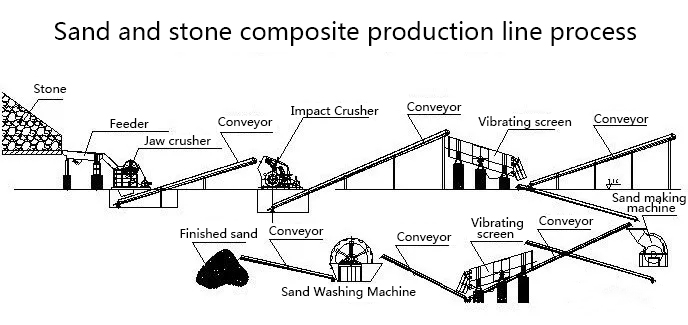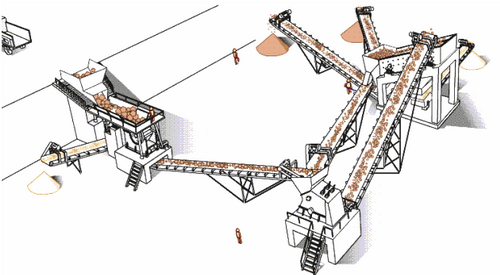Main Equipment Selection and Eight Design Points of Machine-made Sand Production Line
At present, with the endless emergence of infrastructure projects, the production of machine-made sand is in full swing everywhere. Faced with the demand of the sand and gravel market and the increasingly strict environmental protection supervision, it is extremely urgent to do a good job in equipment selection and efficient and environmentally friendly design of the production line. In this paper, the semi-dry sand making process is taken as an example to describe the equipment selection and process design points in the machine-made sand production line for reference.
Main equipment selection
1. The choice of coarse crushing equipment
The coarse crushing equipment used for the production of aggregates is generally rotary crusher, jaw crusher and impact crusher. If the production capacity is high, more than 1000t/h, it is recommended to use a spiral crushing.
2. The choice of medium fine crushing equipment
Medium fine crushing equipment generally has cone crusher and a impact crusher to choose from, and the sand making machine is often used for sand making and shaping at the last stage.
The cone crusher is mainly suitable for crushing rock with high hardness and high abrasive index, and the product has less powdery material.
The impact crusher is mainly suitable for crushing rock with medium or low hardness and abrasive index, and the product has more powdery materials.
If the demand for powdered materials is poor, the standard cone crusher can be used for medium crushing and the short-head cone crusher for fine crushing.

3.Selection of screening and washing equipment
Stone screening equipment generally adopts linear or circular vibrating screen.
The linear vibrating screen has a small processing capacity and is suitable for small particle size screening and small-volume production. It can be used for water filtration of hydrated materials.
The circular vibrating screen has high screening efficiency and large processing capacity, and is suitable for large-size screening and large-scale production.
When the pressure spray system is arranged on the circular vibrating screen, it can be used as a stone washing device. With the hydraulic flushing, the stone rolls and vibrates on the screen surface, and it is easier to wash away the fine mud adhering to the surface.
For the mud powder and stone powder in the 0-4.75mm product, you can choose the spiral sand washing machine or the bucket wheel sand washing machine to obtain the machine-made sand after washing.
4. Selection of wastewater and mud treatment equipment
The sludge-containing wastewater after washing the aggregate of sand and gravel needs to be treated to achieve zero discharge of wastewater from the production line. After the investigation of the wastewater treatment equipment, the system consisting of a cyclone group, a concentrator and a filter press is selected to treat the wastewater and the sludge, which can avoid the shortcomings of large area and difficult cleaning of sedimentation tank caused by that the mud-containing wastewater is directly discharged into sedimentation tank.

Design points of production line
1. Set the intermediate material pile shed
The intermediate material pile shed can adjust the overall system capacity of the aggregate production line. When the coarse crushing section is overhauled, the downstream aggregate production section will not be stopped. When the mining can only be produced in the day shift, the downstream aggregate production section can still be produced in two shifts, and the number of equipment can be reduced. Through the production shift system to adjust system capacity, reduce investment, and the advantages of each equipment in the system have been brought into full play.
2. Make full use of terrain height difference
The design of any production line can be a very good design if it can minimize construction investment and operating costs. Depending on local conditions, making full use of the terrain height difference for process layout can not only reduce civil construction investment and equipment investment, but also reduce production and operation costs.
3. Pre-screening design before medium fine breakage
If the material contains clay, it is usually difficult to remove it by screening. The designed pre-screening can not only screen out the soil-containing wastes smaller than a certain size when the soil content of raw materials is high, but also make the aggregates smaller than the required size after rough breaking no longer go through medium-fine breaking, thereby increasing the system output and reducing the production of powdery materials.
4. The finished sieve is sprayed with a single layer of vibrating screen
The purpose of the first-stage vibrating screen spraying of the semi-dry sand-grain aggregate production line is to remove part of the soil and to make the material that is difficult to be washed wet as early as possible so that the mud-containing material is softened in advance. The second and third grade finished vibrating screens are designed as a single layer, and the purpose of the spray washing is to make each material product have the opportunity to directly contact with the clean water, thereby improving the cleanliness of the aggregate product.
5. Sandstone washing system
For mud-containing wastewater, because of the large amount and particle size of muddy sand , it is not suitable to use slurry pump to transport, and it can only flow through the water tank to the sand washing machine. At this point, the distance of the wastewater flow and the angle of the water tank should be fully considered. As far as possible, the sand washing machine workshop should be placed on a lower section than the vibrating screen workshop, and the water tank is made into a U-shaped groove to reduce friction. In order to avoid the excessive moisture content of materials entering the finished product yard and affecting the sales of products, the filter screens should be set up at the discharging places of sand washer and cyclone set.
6. Waste cement processing system
In the process of the wastewater containing mud powder after sand washing entering the concentration tank, the position of the dosing point and the dosage should be reasonable to improve the effect of the concentrator system. A buffer agitating tank should be installed in front of the filter press to meet the requirements of continuous operation of the slurry pump after the thickener and intermittent operation of the filter press. The choice of filter press capacity should take into account the time required for each job and the requirements of mud cake moisture content.
7. Product storage and delivery
The design point of this link is that at least one or two sets of weighing scales should be set in addition to the appropriate discharge equipment in each pile to adjust the reasonable grading of sandstone to meet the customer's demand for different grades of aggregate.
8.Environmental protection
a) Dust prevention and dust collection measures
In the design, the principle of taking prevention and combining prevention and control is generally adopted. In the process links before the medium fine crushing, try to reduce the dust point and use the conveying and feeding equipment with good sealing performance. Pay attention to the shape and angle of the tube when designing the tube connected with the equipment, and minimize the drop as far as possible. At all dust discharge points, high-efficiency dust collectors with high dust collection efficiency and reliable technology should be used to ensure that the dust emission concentration is lower than the national standard.
The storage of intermediate material and soil waste use closed sheds and spray dust to reduce the impact of dust on the surrounding environment.
b) Noise control
In order to control the noise, the equipment with low noise should be selected as far as possible, and arrange the noise source equipment in the closed workshop, and green outside the workshop to block the noise transmission.
c) Waste water treatment and sludge discharge
The waste water is mainly domestic waste water and sand washing waste water.
After pretreatment, domestic waste water and other waste water are collected into the waste water treatment station for treatment. After reaching the standard, it can be reused in the production line.
Through the sand washing and waste cement processing system, the waste water produced by the sieve washing can be used as production water. The mud cake after sludge treatment and the waste soil generated by pre-screening are used in the mine reclamation cushion to achieve zero discharge of waste water and mud.
This paper mainly introduces the equipment selection and design points of the semi-dry sand production line. In actual production, the aggregate production process and equipment configuration are various. The specific design should be adapted to local conditions and tailored to the production requirements.
Hot News
Recommended Case
- 550TPH Granite Aggregates Production Line in Henan
- 450TPH Limestone Gravel Production Line in Mexico
- 300TPH Feldspar Gravel and Sand Production Line in Gansu
- 200TPH Basalt Aggregate Production Line in Sri Lanka
- 300TPH Coal Gangue Crushing Production Line in Colombia
- 180TPH Waste Rock Crushing Production Line in Australia